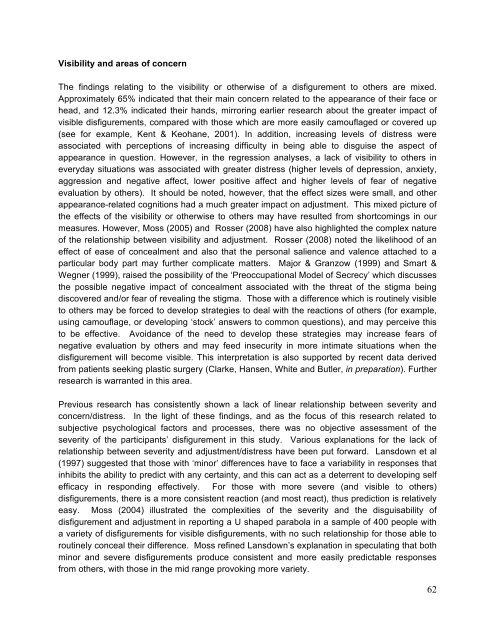Download the report - The Healing Foundation
Download the report - The Healing Foundation
Download the report - The Healing Foundation
You also want an ePaper? Increase the reach of your titles
YUMPU automatically turns print PDFs into web optimized ePapers that Google loves.
Visibility and areas of concern<br />
<strong>The</strong> findings relating to <strong>the</strong> visibility or o<strong>the</strong>rwise of a disfigurement to o<strong>the</strong>rs are mixed.<br />
Approximately 65% indicated that <strong>the</strong>ir main concern related to <strong>the</strong> appearance of <strong>the</strong>ir face or<br />
head, and 12.3% indicated <strong>the</strong>ir hands, mirroring earlier research about <strong>the</strong> greater impact of<br />
visible disfigurements, compared with those which are more easily camouflaged or covered up<br />
(see for example, Kent & Keohane, 2001). In addition, increasing levels of distress were<br />
associated with perceptions of increasing difficulty in being able to disguise <strong>the</strong> aspect of<br />
appearance in question. However, in <strong>the</strong> regression analyses, a lack of visibility to o<strong>the</strong>rs in<br />
everyday situations was associated with greater distress (higher levels of depression, anxiety,<br />
aggression and negative affect, lower positive affect and higher levels of fear of negative<br />
evaluation by o<strong>the</strong>rs). It should be noted, however, that <strong>the</strong> effect sizes were small, and o<strong>the</strong>r<br />
appearance-related cognitions had a much greater impact on adjustment. This mixed picture of<br />
<strong>the</strong> effects of <strong>the</strong> visibility or o<strong>the</strong>rwise to o<strong>the</strong>rs may have resulted from shortcomings in our<br />
measures. However, Moss (2005) and Rosser (2008) have also highlighted <strong>the</strong> complex nature<br />
of <strong>the</strong> relationship between visibility and adjustment. Rosser (2008) noted <strong>the</strong> likelihood of an<br />
effect of ease of concealment and also that <strong>the</strong> personal salience and valence attached to a<br />
particular body part may fur<strong>the</strong>r complicate matters. Major & Granzow (1999) and Smart &<br />
Wegner (1999), raised <strong>the</strong> possibility of <strong>the</strong> ‘Preoccupational Model of Secrecy’ which discusses<br />
<strong>the</strong> possible negative impact of concealment associated with <strong>the</strong> threat of <strong>the</strong> stigma being<br />
discovered and/or fear of revealing <strong>the</strong> stigma. Those with a difference which is routinely visible<br />
to o<strong>the</strong>rs may be forced to develop strategies to deal with <strong>the</strong> reactions of o<strong>the</strong>rs (for example,<br />
using camouflage, or developing ‘stock’ answers to common questions), and may perceive this<br />
to be effective. Avoidance of <strong>the</strong> need to develop <strong>the</strong>se strategies may increase fears of<br />
negative evaluation by o<strong>the</strong>rs and may feed insecurity in more intimate situations when <strong>the</strong><br />
disfigurement will become visible. This interpretation is also supported by recent data derived<br />
from patients seeking plastic surgery (Clarke, Hansen, White and Butler, in preparation). Fur<strong>the</strong>r<br />
research is warranted in this area.<br />
Previous research has consistently shown a lack of linear relationship between severity and<br />
concern/distress. In <strong>the</strong> light of <strong>the</strong>se findings, and as <strong>the</strong> focus of this research related to<br />
subjective psychological factors and processes, <strong>the</strong>re was no objective assessment of <strong>the</strong><br />
severity of <strong>the</strong> participants’ disfigurement in this study. Various explanations for <strong>the</strong> lack of<br />
relationship between severity and adjustment/distress have been put forward. Lansdown et al<br />
(1997) suggested that those with ‘minor’ differences have to face a variability in responses that<br />
inhibits <strong>the</strong> ability to predict with any certainty, and this can act as a deterrent to developing self<br />
efficacy in responding effectively. For those with more severe (and visible to o<strong>the</strong>rs)<br />
disfigurements, <strong>the</strong>re is a more consistent reaction (and most react), thus prediction is relatively<br />
easy. Moss (2004) illustrated <strong>the</strong> complexities of <strong>the</strong> severity and <strong>the</strong> disguisability of<br />
disfigurement and adjustment in <strong>report</strong>ing a U shaped parabola in a sample of 400 people with<br />
a variety of disfigurements for visible disfigurements, with no such relationship for those able to<br />
routinely conceal <strong>the</strong>ir difference. Moss refined Lansdown’s explanation in speculating that both<br />
minor and severe disfigurements produce consistent and more easily predictable responses<br />
from o<strong>the</strong>rs, with those in <strong>the</strong> mid range provoking more variety.<br />
62


